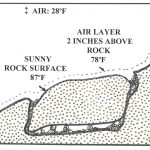
Walk along the flood channel of Perry Lake in January and you will need a parka—it is cold. But look down on the large rocks that line the sluice-way and you may see a large spider on nearly every rock! What is a warm-weather spider doing out in this cold weather?
There may be snow on the shady side of each rock, but take off your gloves and you can feel how the sunshine on the surface of these rocks makes them toasty warm. And for an inch or two above the rock surface, there is a nice layer of warm air. As far as these spiders are concerned, this is a warm summer day.
Weather comes in scales. Global weather patterns have cold air that sinks at the Poles and hot tropical air that evaporates the oceans. Then there are regional weather patterns: the high and low pressures and the warm and cold fronts that we see on TV weather forecasts.
But here at Perry Lake, the spiders are “feeling good” living in their own microclimate, the conditions that occur in just a few inches.
You and I don’t feel these differences because we are so big we walk through the atmosphere above. But the smaller life beneath our feet lives in the cracks and crevices that insulate them from the weather changes that are greatest just above the surface. These wolf spiders never feel the freezing cold. They just move down under the large stones to below the frost line.
They are out on this thin warm surface today for a meal. Small mosquito-like flies called midges emerge this time of year from the sluice-way and land on the warm rocks. It is dinnertime. It must be “good eating” because these wolf spiders are among the biggest specimens collected.
Nearly every rock has a spider on it. Wolf spiders are solitary spiders. These spiders not only eat midges, but they also eat each other. Scoop up a spider from one rock and dump it on a rock that has another spider. They size up each other from a distance and one immediately decides to leave. The spider that leaves jumps to another rock where there is another wolf spider and the confrontation begins again. The spiders play king-of-the-hill and domino across the rocks until finally the last one finds an empty rock.
This wolf spider is Pardosa lapidicina, a species known to live just a few yards up the banks from streams and rivers. At Perry Lake, they are right where they are supposed to be: plenty of food and a warm rock—in January.



